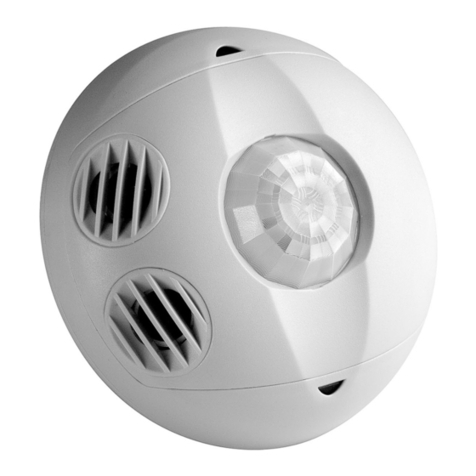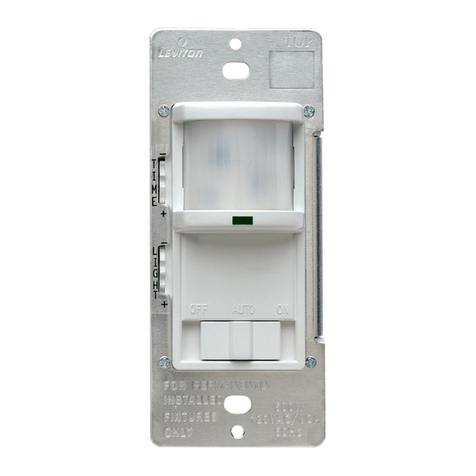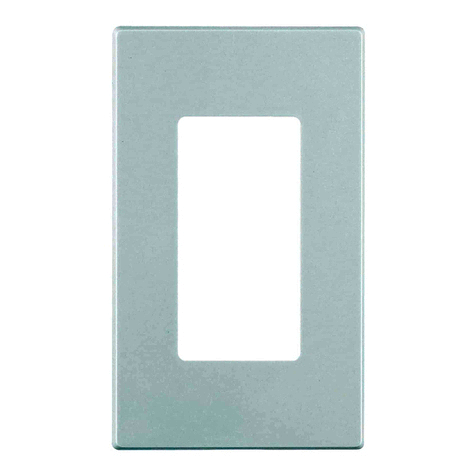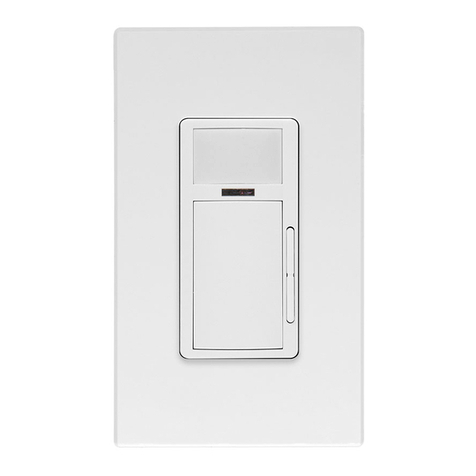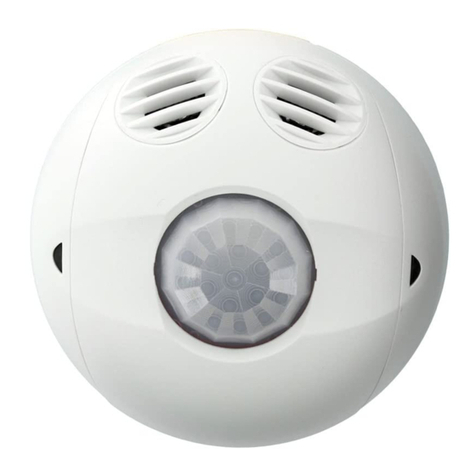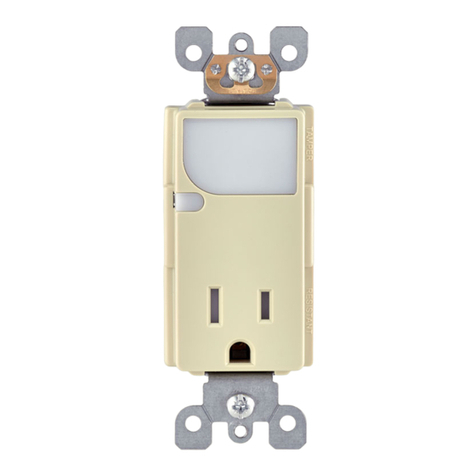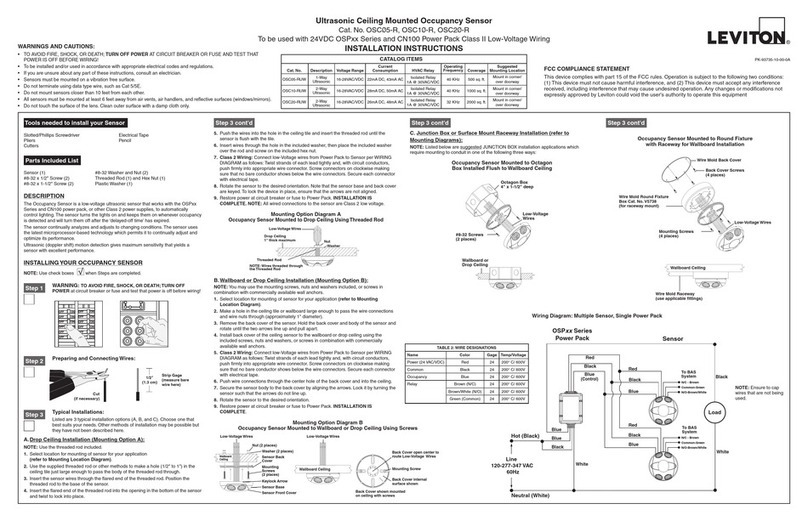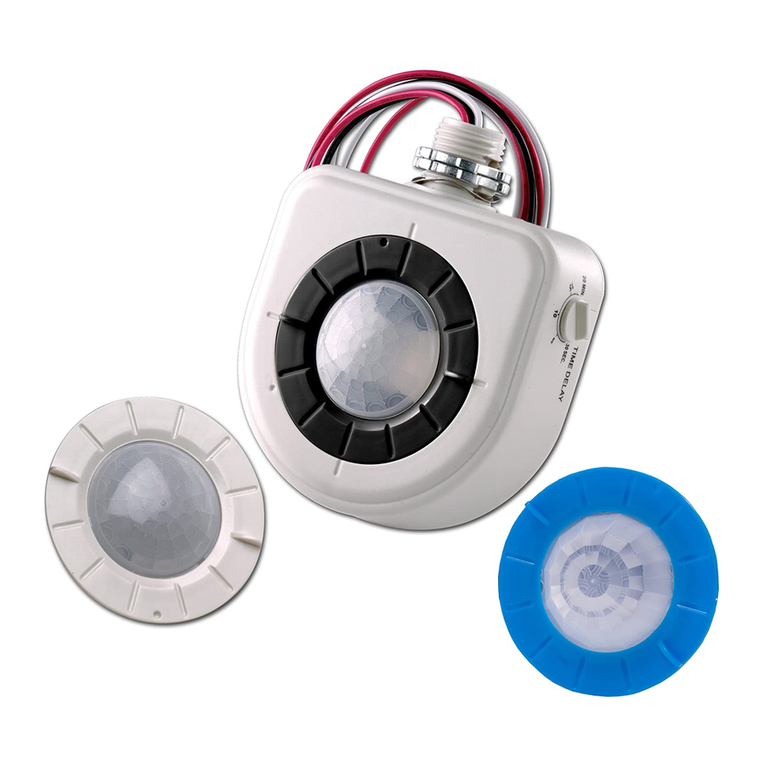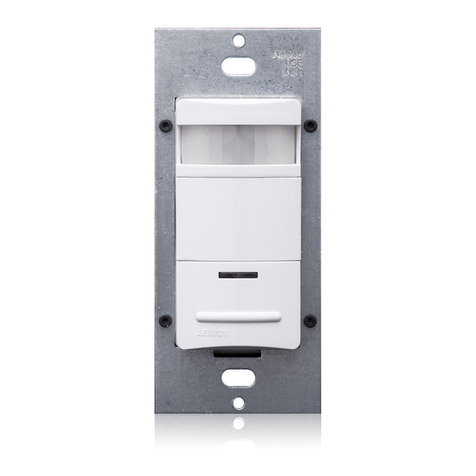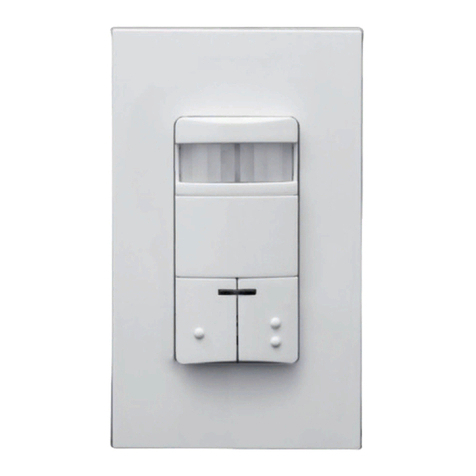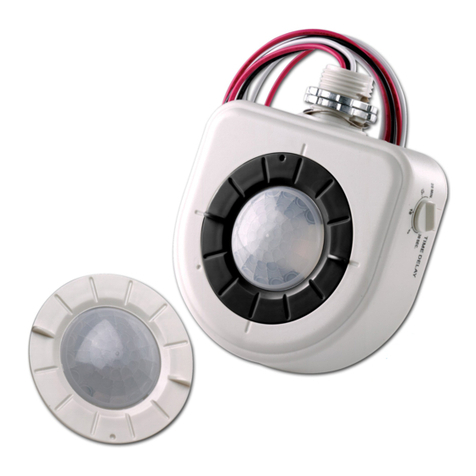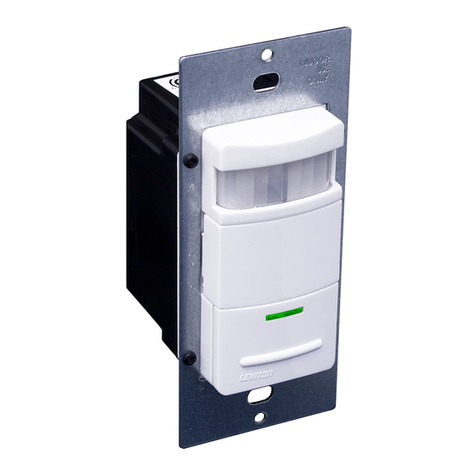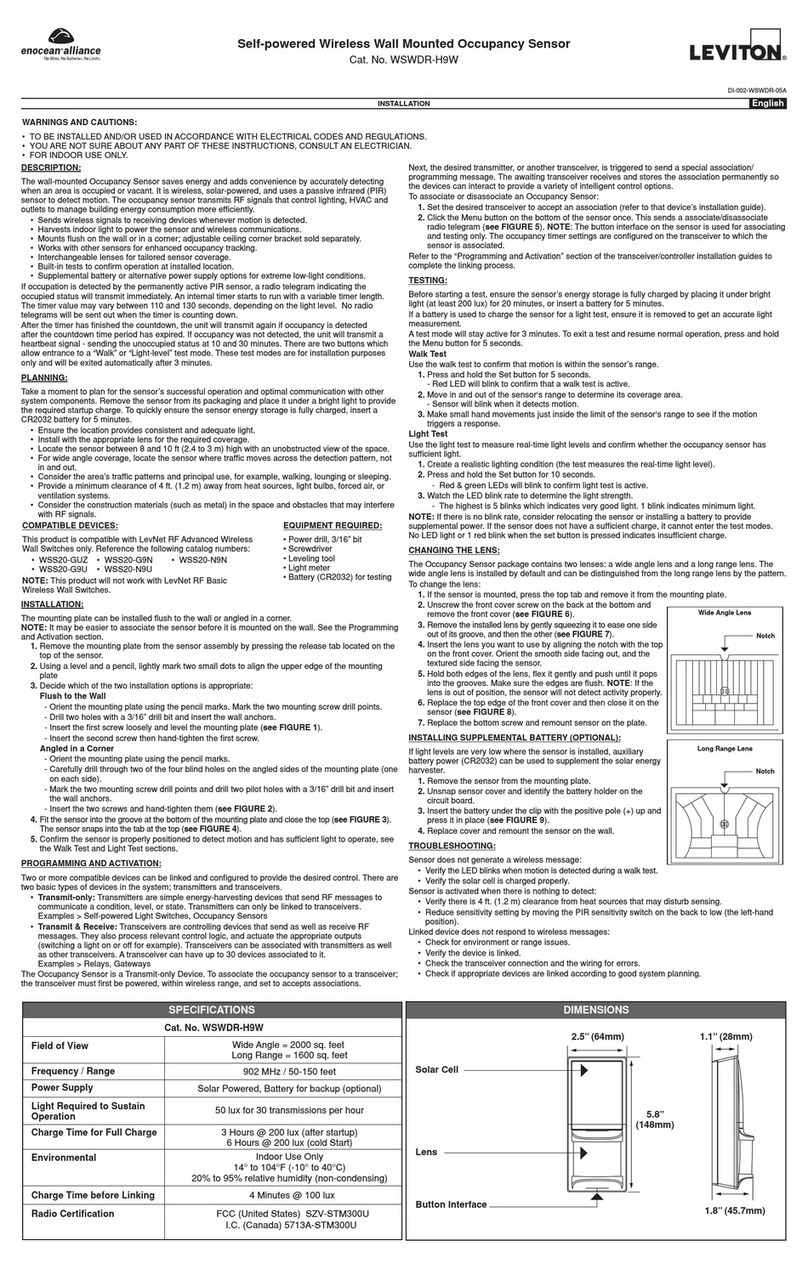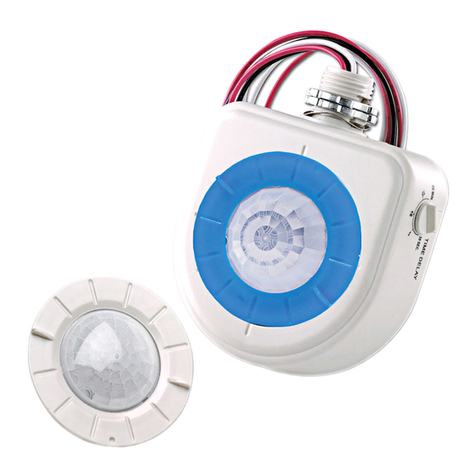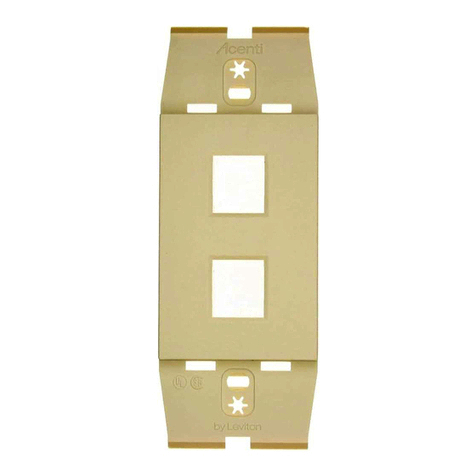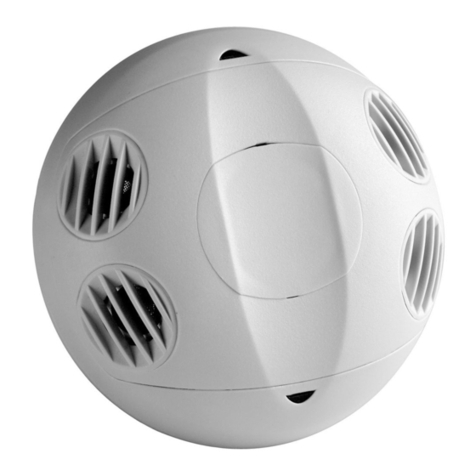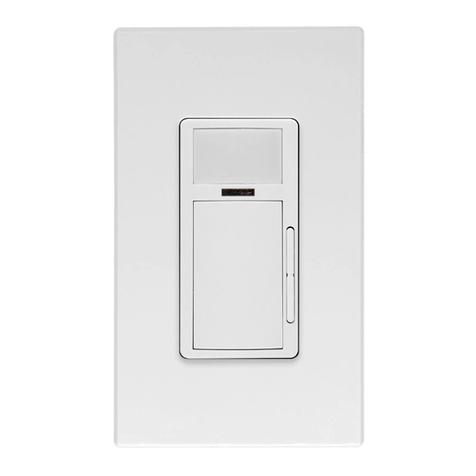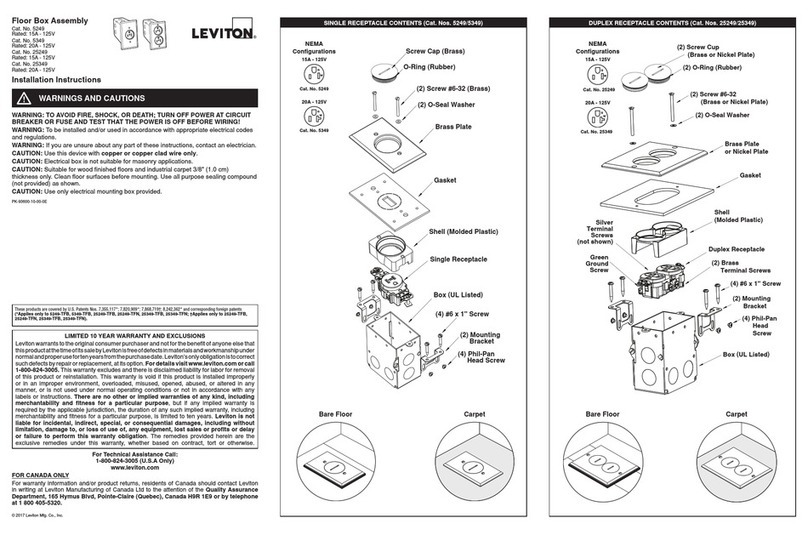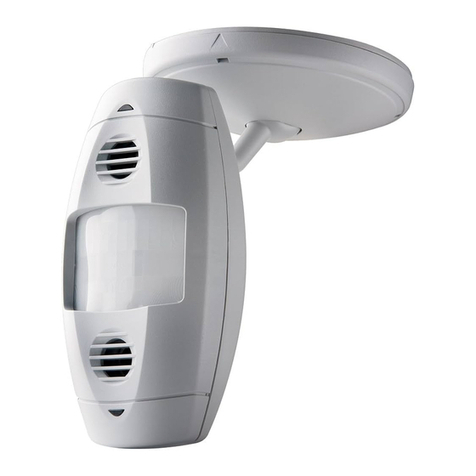
Self-powered Wireless Light Sensor
Cat. No. WSCPC
DI-000-WSCPC-00A
INSTALLATION
WARNINGS AND CAUTIONS:
• TO BE INSTALLED AND/OR USED IN ACCORDANCE WITH ELECTRICAL CODES AND REGULATIONS.
• IF YOU ARE NOT SURE ABOUT ANY PART OF THESE INSTRUCTIONS, CONSULT AN ELECTRICIAN.
• TO BE USED FOR INDOOR APPLICATIONS ONLY(10-30°C ENVIRONMENTS).
• DO NOT EXPOSE THIS DEVICE TO DIRECT SUNLIGHT. IT IS INTENDED FOR INDOOR USE ONLY, WITH OPERATIONAL LIGHTING REQUIREMENTS FROM 4 TO 100 FOOT CANDLES (1000 LUX)
DO NOT EXPOSE THIS DEVICE TO CONDITIONS IN EXCESS OF 100 FC (10,000 LUX).
DESCRIPTION:
The Wireless Light Sensor is a solar powered & battery-free wireless transmitter that communicates with a wide variety of receivers. The Light Sensor is used to adjust articial light when enough natural light
is available in order to help facility managers to conserve energy and shave utility costs. Energy is harvested from the light captured by the solar cells on the Light Sensor. This energy is used by a built-in
transmitter to send wireless signals every 60 seconds (+/-) to command a designated receiver to control lighting level.
A switch can also be added to control the lights.
COMPATIBLE DEVICES:
• 3-Wire Relay
• 5-Wire Relay
• E3X-BACFP Central Controller
• More receivers available
EQUIPMENT NEEDED FOR INSTALLATION
• Non conductive stylus, or ballpoint pen
• Screwdriver
• Double Sided Foam Mounting Tape
• Wall Anchors and Screws (Anchors Not included - for “screw to” mounting)
PROGRAMMING AND ACTIVATION:
1. Do not mount the sensor until after it has been programmed to communicate with all appropriate receivers.
2. Make sure the sensor is within 15 feet (5 meters) of the desired receiver when programming.
3. Programming: To associate a sensor with a receiver, press the Teach button (center button on front cover) on the
Wireless Light Sensor while the receiver is in the desired Program Mode (see receiver instructions for programming).
4. Activation: The Light Sensor can operate in one of two modes, ON/OFF Mode or Light
Level Mode.
- ON/OFF mode is used to control relays and other switching devices.
- Light Level Mode is used to control the light level of dimming devices. The Light Sensor
transmits the light level every 60 seconds (+/-), depending on the light level. The
dimming device can use this information to adjust brightness.
Use the DIP switch on the back of the Light Sensor to set the mode. DIP switch number 1
in the ON position is the ON/OFF Mode, and in the OFF position is Light Level Mode.
Note: DIP switch 2 is a placeholder for future use.
Choose which mode you want to operate in and set the DIP switch accordingly.
PLEASE NOTE: Do not attempt to activate loads while receivers are in Program Mode or other
devices could be accidentally added or deleted from memory. Receivers have reduced range during
programming. Wireless Light Sensor start up time is 2-4 minutes out of the box depending on light
source (keep this in mind while considering mounting location). Wireless Light Sensor Self Powered
light requirements are approximately 20 foot candles for 3 hours every 24 hours (keep this in mind
while considering mounting location). If these requirements cannot be met, consider utilizing battery backup feature
located underneath the sensor as the power source for your application.
5. Once the Light Sensor has been programmed to a receiver, set the desired light level using the adjustment on the
Light Sensor.
Note: When using ON/OFF mode, the light level adjustment can be made in one of two ways.
1. By looking at the graph in the installation guide, adjust the potentiometer to the position corresponding to the light levels desired. For example, if you want the lights to turn ON at 40 LUX and OFF at
100 LUX, turn the potentiometer fully counter-clockwise (to the left). For a turn ON level at 408 LUX and a turn OFF level at 1020 LUX, turn the potentiometer fully clockwise (to the right).
2. Press and hold the "Teach" button for about 7 seconds. The sensor will switch into a mode where it does not transmit radio messages, but rather blinks the LED briey to indicate whether the light level
is above the "turn OFF" threshold or below the threshold. One blink for "below" and two blinks for "above." After 30 seconds the sensor will automatically time out, returning to normal operation. While
in this mode, use a screwdriver to adjust the potentiometer to set The desired light level. Note that it is helpful to have the light level in the room adjusted, by adjusting the window blinds (or similar
means), so the light level matches the desired "turn ON" level.
Note: The presence of a person near the sensor will affect the light reading, and depending on room light and the color of the person’s clothing, the reading may be either higher or lower.
Remember when adjusting the sensor that transmissions occur relatively slowly.
FUNCTIONALITY:
Transmit Interval:
The Light Sensor transmits every 30 seconds in the presence of very bright light (several hundred lux or more). An abundance of light allows for more energy to transmit, so transmissions occur more often. Also,
when it is lighter, generally it is likely that people are present, and the system will respond more quickly with more frequent transmissions.
The sensor wakes up every few seconds to measure the light when there is an abundance of light available. If the light level changes quickly, the sensor may transmit within a few seconds of the change. If the
light continues to uctuate, however, the sensor will not continue transmitting every change of light level. The FCC limits the number of transmissions per hour.
In lower light levels, the transmission rate slows down, and when in darkness (or near it) transmissions only occur every 15 minutes. At this slow rate, the sensor only wakes up to check the room light level every
90 seconds. This conserves energy but still provides data to wireless receivers often enough to maintain system integrity.
Light Level Sensing:
See specications table for minimum and maximun operating light levels.
The light level seen by a sensor on the ceiling of a typical ofce may be in the range of 120 to 200 lux. The light on the work surfaces is generally higher than this.
The Light Sensor operates wirelessly and battery free as long as the device receives at least 200 lux for 3 hours a day (or less light for a longer time period each day). It is recommended to initially
charge the internal energy storage by placing the sensor in bright light (1000 lux or more) under a desk lamp or similar for several hours. If the device is not pre-charged in this manner, the sensor
will not operate in darkness for several days or more (depending on ambient light level).
Backup Battery:
An internal battery option is available to operate in dark environments. The battery is a 1/2 AA 3.6V long-life lithium battery. When light is present, the battery is not used, making the life mostly dependent on the
self-discharge characteristics of the battery. In darkness, the sensor requires less than 10 microamps of current. For a 1000 mA-hour 3.6 V lithium battery, this equates to a 100,000 hour life, or about 10 years.
However, the battery self-discharge reduces this life, and the self-discharge rate depends on battery brand, temperature, and other factors.
Two wiring connections are provided for external power sources. The wires accept either AC or DC power from 8 to 30 VAC or VDC.
Buttons:
The Center button, with a radio wave symbol, transmits a “Teach” telegram (radio signal) so receivers can teach, or associate with, the Light Sensor.
The “I” button (capital I) sends a message that no light is present (0 foot candles/lux), so if the controller is designed to do so, the lights will turn ON.
The “O” button (capital O, not zero) sends a message that 1020 lux (or more) of light is present, so the controller (generally) will turn the lights OFF. The I and O buttons are for testing the system.
Pressing the buttons too often or too rapidly may deplete the energy storage when not fully charged.
External Antenna:
When greater range is desired (than is possible with the internal antenna) the antenna can be routed externally through the hole in the side of the enclosure and for best appearance can be placed in the
antenna sheath. When mounting the sensor on or near metal, the external option is highly recommended. In general it will always increase range, so unless the external antenna creates aesthetic issues, it is
recommended to use it. The antenna can also exit the wall plate up into ceiling cavities.
Adjustment Tool:
The small plastic screwdriver is used for adjusting the sensor level, when used in the ON/OFF mode. When the sensor has the rst DIP switch (inside the back cover) turned
OFF, the sensor will transmit the actual measured light level (0 to 1020 lux). Some controllers do not have knobs or other adjustments to set the desired room light level, so
another mode is provided. The sensor ships, by default, with the rst DIP switch in the “ON” position. In this mode the sensor will only transmit a level of 0 lux or 1020 lux. If the
light detected by the sensor is below the lower threshold (see graph) the light sensor transmits a “0 lux” message (even though the actual measured light is not zero, it allows the
controller to look for a simple ON/OFF message) causing the lights to turn ON. When the light detected by the sensor is above the upper threshold, the sensor transmits a “1020
lux” message, causing the room lights to turn OFF. In between the two thresholds is a deadband, an area where the sensor transmits no messages. Without this deadband, the
lights could cycle ON and OFF when the room light is near the threshold level.
For example, if the adjustment knob is at its lowest (counterclockwise) position, and it detects a light level greater than 100 lux, it will send a “1020 lux” message, turning the
lights OFF. If the sensor detects a level between 40 lux and 100 lux, it will not transmit, leaving the lights unchanged. If it detects a light level below 40 lux, it will send a “0 lux”
message, turning the lights ON. If the adjustment knob were at the highest (clockwise) position, the sensor would not turn the lights ON until the sensor measures 408 lux or
more. Location of the Light Sensor is important. Amount of articial and natural light seen by the sensor needs to be taken into account in adjusting to reach desired results.
SPECIFICATIONS
WSCPC
F.O.V.
60 Degree Cone
Range
20-150 feet (Typical)
Transmission Interval
10 seconds (plus/minus)
Minimum Light Required
4FC (40 LUX)
Solar Cell Operating Range
2-1000FC (20-10,000 LUX)
Measurement Range
0-100 FC (0-1000 LUX)
Minimum Charge Time to
Begin Operation
1 minute @ 20FC (200 LUX)
Maximum Charge Time
24 hours @ 100FC (1000 LUX)
Maintain Charge Time
3 hours per 24 hours @ 20FC
Operating Life at Full Charge
72 hours
Optional Battery Life
10 years
Operating Temperature Range
32°F to 104°F (0°C to 40°C)
Storage Temperature Range -4°F to 158°F (-20°C to 70°C)
Relative Humidity 0% to 95%, non-condensing
Usage Indoors only
Mounting Height 8-12 feet
Dimensions
3.14(W) x 3.69(H) x 1.03(D)
Power Supply
Solar Powered, Battery for backup (not required)*
Channels
1 Channel
Output Channels
Only limited by number of receivers in range
Addressing
Factory set unique ID (1 of 4 billion)
Radio Certication
FCC (United States) Pending
I.C. (Canada) Pending
*Optional Battery - 1/2 AA, 3.6v Lithium
“ON” (zero light)
“OFF” (1020 lux light)
Teach Button
Sensor Buttons
Antenna Mounting Options
2 1
OFF
ON
DIP Switch
on Sensor
